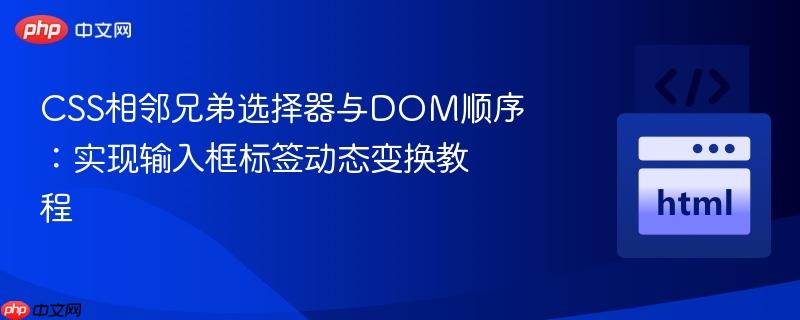
在css中,相邻兄弟选择器(+)用于选择紧跟在指定元素 之后 的第一个兄弟元素。例如,a + b 会选择紧邻在a元素后面的b元素。这是一个关键的限制:css选择器无法选择dom中位于当前元素 之前 的兄弟元素。
考虑以下常见的HTML结构,旨在实现输入框聚焦时标签的动态变换:
<div class="input-group"> <label for="user" class="user-label">Username</label> <input type="text" name="user" class="user-input" required> </div>
如果尝试使用如下CSS来变换标签:
.user-input:focus + .user-label {
/* 预期变换效果 */
color: yellow;
transform: translate(10px, -14px) scale(.8);
}这段CSS将不会生效。原因在于,在上述HTML结构中,<label>元素位于<input>元素 之前。user-input:focus + .user-label 尝试选择紧邻在.user-input 之后 的.user-label,而实际上.user-label并不在.user-input之后,因此选择器无法匹配到任何元素。
要解决这个问题,我们需要采取两步策略:
立即学习“前端免费学习笔记(深入)”;
首先,调整HTML代码,将<input>放在<label>之前:
<div class="container">
<div class="input-group">
<input type="text" name="user" class="user-input" required>
<label for="user" class="user-label">Username</label>
</div>
</div>现在,.user-label 已经是 .user-input 的相邻兄弟元素,并且位于其 之后。
接下来,应用CSS来控制布局和动画效果。
.input-group {
display: flex; /* 启用Flexbox布局 */
flex-direction: row-reverse; /* 反转子元素(input和label)的显示顺序 */
justify-content: flex-end; /* 将内容推向右侧,可选,取决于具体布局需求 */
/* 或者 justify-content: start; 如果希望左对齐 */
position: relative; /* 如果需要绝对定位子元素,父元素应有定位 */
overflow: hidden; /* 确保变换不会溢出容器 */
}
.user-label {
transition: 0.5s; /* 为标签的变换添加平滑过渡效果 */
/* 初始样式,例如定位 */
position: absolute;
left: 0;
top: 50%;
transform: translateY(-50%);
pointer-events: none; /* 确保点击标签时焦点能落到input上 */
color: #888;
}
.user-input {
/* 输入框基础样式 */
padding: 10px;
border: 1px solid #ccc;
width: 100%; /* 填充父容器宽度 */
box-sizing: border-box; /* 边框和内边距包含在宽度内 */
background: transparent; /* 背景透明,以便看到标签 */
z-index: 1; /* 确保input在label之上,便于交互 */
}
/* 当输入框聚焦、内容有效或被激活时,变换标签 */
.user-input:focus + .user-label,
.user-input:valid + .user-label,
.user-input:active + .user-label {
color: yellow; /* 改变颜色 */
transform: translate(10px, -14px) scale(.8); /* 向上移动并缩小 */
/* 确保z-index在input之下或根据需要调整 */
z-index: 0;
}代码解释:
结合上述HTML和CSS,以下是实现动态变换标签的完整示例:
HTML:
<div class="container">
<div class="input-group">
<input type="text" id="user" name="user" class="user-input" required>
<label for="user" class="user-label">Username</label>
</div>
<div class="input-group" style="margin-top: 20px;">
<input type="email" id="email" name="email" class="user-input" required>
<label for="email" class="user-label">Email Address</label>
</div>
</div>CSS:
body {
font-family: Arial, sans-serif;
display: flex;
justify-content: center;
align-items: center;
min-height: 100vh;
background-color: #282c34;
color: #fff;
margin: 0;
}
.container {
background-color: #3a404a;
padding: 30px;
border-radius: 8px;
box-shadow: 0 4px 8px rgba(0, 0, 0, 0.2);
width: 300px;
}
.input-group {
display: flex;
flex-direction: row-reverse; /* 关键:反转DOM顺序的视觉呈现 */
justify-content: flex-end; /* 确保内容靠右对齐,与label的position:absolute配合 */
position: relative; /* 为内部的绝对定位元素提供参考 */
height: 40px; /* 设定一个固定高度,防止布局抖动 */
margin-bottom: 20px;
border: 1px solid #555;
border-radius: 4px;
}
.user-label {
position: absolute;
left: 10px; /* 初始位置 */
top: 50%;
transform: translateY(-50%); /* 垂直居中 */
color: #bbb;
transition: 0.3s ease-out; /* 平滑过渡 */
pointer-events: none; /* 确保点击穿透到input */
font-size: 1em;
padding: 0 5px; /* 稍微增加内边距,模拟浮动标签效果 */
background-color: transparent; /* 初始背景透明 */
z-index: 1; /* 确保label在input之上,但会被input背景覆盖 */
}
.user-input {
width: 100%;
padding: 10px 10px;
border: none;
outline: none;
background-color: transparent; /* 背景透明,让label可见 */
color: #fff;
font-size: 1em;
z-index: 2; /* 确保input可交互 */
}
/* 当输入框聚焦、内容有效或被激活时,变换标签 */
.user-input:focus + .user-label,
.user-input:valid + .user-label,
.user-input:active + .user-label {
color: yellow;
transform: translate(0px, -20px) scale(.8); /* 向上移动并缩小 */
background-color: #3a404a; /* 变换后背景色与父容器一致,形成“浮动”效果 */
padding: 0 5px; /* 保持内边距 */
left: 5px; /* 微调位置 */
}
/* 当input有内容但未聚焦时,label也应保持变换状态 */
.user-input:not(:placeholder-shown):not(:focus) + .user-label {
transform: translate(0px, -20px) scale(.8);
color: #bbb; /* 保持颜色 */
background-color: #3a404a;
padding: 0 5px;
left: 5px;
}通过以上方法,开发者可以克服CSS选择器的限制,优雅地实现输入框标签的动态变换效果,提升用户界面的交互性和美观度。
以上就是CSS相邻兄弟选择器与DOM顺序:实现输入框标签动态变换教程的详细内容,更多请关注php中文网其它相关文章!

每个人都需要一台速度更快、更稳定的 PC。随着时间的推移,垃圾文件、旧注册表数据和不必要的后台进程会占用资源并降低性能。幸运的是,许多工具可以让 Windows 保持平稳运行。

Copyright 2014-2025 https://www.php.cn/ All Rights Reserved | php.cn | 湘ICP备2023035733号